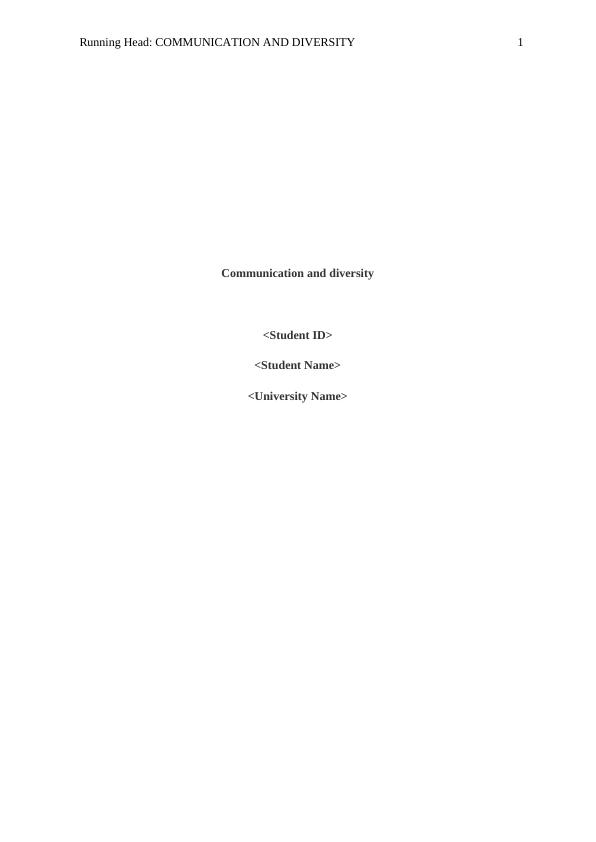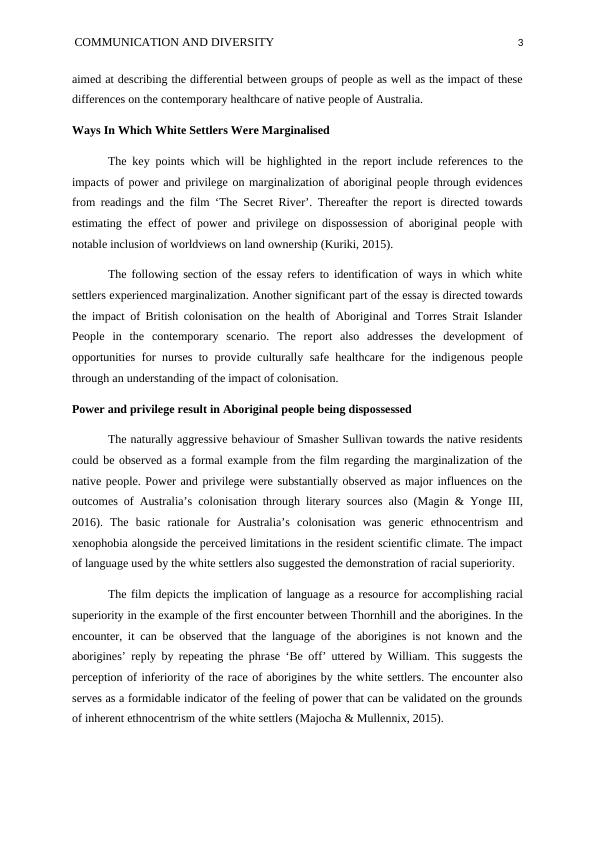Communication and Diversity- Introduction
Added on 2020-02-19
7 Pages2103 Words139 Views
Running Head: COMMUNICATION AND DIVERSITY 1Communication and diversity<Student ID><Student Name><University Name>

COMMUNICATION AND DIVERSITY2Introduction:The secret river is a novel written by an Australian author, Kate Greenville, which hasbeen adapted for theatre plays and television film. The novel’s major backdrop is vested inthe British expansion in New South Wales and the relevant scenarios depicting theinteractions between the white settlers and the aboriginal people in Australia. The definitionof privilege could be identified as the exceptional advantage, immunity and rights anointed oraccessed by a specific community or individual. Power can be defined in this context as theability for influencing the behaviour of other individuals or course of events. Power and privilege result in Aboriginal people being marginalisedThe observation of power and privilege in the case of the secret river could beobserved in the unwarranted treatment of the Aboriginal and Torres Strait Islander Peoples bythe newly arrived white settlers on the basis of racial superiority thereby depictingunauthorized exercise of power. Furthermore, the white settlers also depict potentialhighlights of privilege since they assumed control over the unclaimed lands in the area of theindigenous people without being concerned about the native laws regarding land ownership(Curşeu, 2013). The identification of the large scale marginalization of the indigenous people of NewSouth Wales i.e. the Aboriginals and Torres Strait Islander Peoples could be considered as amajor impact on their health alongside concerns of cultural safety (UTS: Indigenous HealthResources, 2017). The current health status of the native people could be apprehended fromthe depiction of favourable health conditions among individuals above the age of 15 yearsthat reported their health conditions as excellent or good. On the contrary, lower proportionof females of the indigenous population has indicated fair health i.e. 37% as compared to42% among males (Fujii, 2014). However, the health status of Aboriginal and Torres StraitIslander Peoples is comparatively inferior that that of the non-aboriginal people alongside theobservation of a substantial gap between the populations of older age people in each segment.Furthermore, the natives have also depicted profound indications of various health conditionsreferring to kidney diseases and circulatory diseases alongside the prominence of risk factorssuch as smoking (Hou, 2016). The interpretation of health status of the indigenous people refers to the influence ofthe disparities between the worldview and the person’s view of health. The following essay is

COMMUNICATION AND DIVERSITY3aimed at describing the differential between groups of people as well as the impact of thesedifferences on the contemporary healthcare of native people of Australia. Ways In Which White Settlers Were MarginalisedThe key points which will be highlighted in the report include references to theimpacts of power and privilege on marginalization of aboriginal people through evidencesfrom readings and the film ‘The Secret River’. Thereafter the report is directed towardsestimating the effect of power and privilege on dispossession of aboriginal people withnotable inclusion of worldviews on land ownership (Kuriki, 2015). The following section of the essay refers to identification of ways in which whitesettlers experienced marginalization. Another significant part of the essay is directed towardsthe impact of British colonisation on the health of Aboriginal and Torres Strait IslanderPeople in the contemporary scenario. The report also addresses the development ofopportunities for nurses to provide culturally safe healthcare for the indigenous peoplethrough an understanding of the impact of colonisation. Power and privilege result in Aboriginal people being dispossessedThe naturally aggressive behaviour of Smasher Sullivan towards the native residentscould be observed as a formal example from the film regarding the marginalization of thenative people. Power and privilege were substantially observed as major influences on theoutcomes of Australia’s colonisation through literary sources also (Magin & Yonge III,2016). The basic rationale for Australia’s colonisation was generic ethnocentrism andxenophobia alongside the perceived limitations in the resident scientific climate. The impactof language used by the white settlers also suggested the demonstration of racial superiority. The film depicts the implication of language as a resource for accomplishing racialsuperiority in the example of the first encounter between Thornhill and the aborigines. In theencounter, it can be observed that the language of the aborigines is not known and theaborigines’ reply by repeating the phrase ‘Be off’ uttered by William. This suggests theperception of inferiority of the race of aborigines by the white settlers. The encounter alsoserves as a formidable indicator of the feeling of power that can be validated on the groundsof inherent ethnocentrism of the white settlers (Majocha & Mullennix, 2015).

End of preview
Want to access all the pages? Upload your documents or become a member.
Related Documents
Communication and Diversity Assignmentlg...
|7
|1671
|48
Communication and Diversity : Assignmentlg...
|8
|1863
|226
Aboriginal and Torres Strait Islanders’ Wellbeinglg...
|10
|2766
|395
The Impact of Colonization on Aboriginal and Torres Strait Islander People in Australialg...
|8
|2257
|3
Deconstruction Essay on Indigenous Healthlg...
|10
|2615
|1
Critical Reflection on Indigenous Culture and Healthlg...
|4
|902
|196
